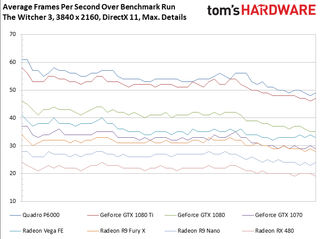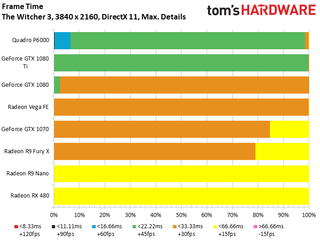AMD Radeon Vega Frontier Edition 16GB Review
Why you can trust Tom's Hardware
DirectX 11 Gaming Performance
According to AMD, the Radeon Vega FE isn't aimed at gamers. But you're still able to game on it. We do know the card's drivers aren't fully baked, though. At its recent Siggraph tech day, AMD let us know the Draw Stream Binning Rasterizer isn't enabled yet, for starters. It sounds like the driver package accompanying Radeon RX Vega 64 will be better optimized for this use case.
This is why we didn't spend a ton of time cranking out game benchmarks on the Frontier Edition card. Instead, we chose one title each to represent the three most important categories at resolutions enthusiasts play at. Running tests at a higher resolution also stifles any potential CPU bottleneck.
The Witcher 3 (DirectX 11)
This game’s a classic, making it the subject of many driver optimizations from both manufacturers. That's alright with us, given how long AMD and Nvidia have had to make their hardware hum well in The Witcher 3. Consequently, we should end up with an objective comparison of each board configuration, and that's exactly what we want. First, the average frame rates:

Next, we have frame rate over time across the benchmark run:

Frame times are an important part of the picture as well, so we provide them in line and bar graph form.

Things look good all the way down to AMD's Radeon Vega FE. The difference between Nvidia’s Quadro P6000, which hits its power limit and throttles back, and the GeForce GTX 1080 Ti is quite remarkable. GPU Boost’s restrictive approach makes the card look kind of jumpy; you can see the outcome of this in our bar graph:

In order to evaluate smoothness, a look at frame time variance is in order.
AMD's Radeon Vega FE isn't the fastest card in our field, but it does provide a balanced experience that outclasses the previous-gen Fiji and lower-end Polaris GPUs. Even Nvidia's GeForce GTX 1080 Ti and Quadro P6000 have to cede the field to the three top cards.

However, frame time variance has to be considered in the context of a graphics card's base performance. This is what our unevenness index is for.
AMD’s Radeon Vega FE naturally beats its predecessors, but only ends up between Nvidia's GeForce GTX 1080 and 1070. At least it's closer to the 1080 than the 1070.

For each card in our line-up, we generated a variance and playability chart so you can compare their results:
















At least for now, the results are sobering. AMD’s Radeon Vega FE can’t even compete with the GeForce GTX 1080 Founders Edition. That's just not good enough, given the amount of time enthusiasts have been waiting for a new flagship from AMD. The company just announced its gaming-specific models, so we'll wait for those cards (and their drivers) for a more definitive conclusion. But for now, it's fairly safe to say the Frontier Edition card isn't what you should spend money on if gaming is a priority.
MORE: Best Graphics Cards
MORE: Desktop GPU Performance Hierarchy Table
MORE: All Graphics Content
Current page: DirectX 11 Gaming Performance
Prev Page 3D Workstation Performance Next Page DirectX 12 Gaming PerformanceStay on the Cutting Edge
Join the experts who read Tom's Hardware for the inside track on enthusiast PC tech news — and have for over 25 years. We'll send breaking news and in-depth reviews of CPUs, GPUs, AI, maker hardware and more straight to your inbox.
-
Ne0Wolf7 Too bad its been so well optimized for Creo, I hate that one... Anyways, is it possible to include Autodesk Inventor in the suite? I want a card that can be used as a hybrid like this (of course I'll have to wait for it to come down in price) but its hard to decide I want something if my main software is not included in the benchmarks. Either way, I'm exited and this is a good reviewReply -
cknobman Not sure what to think here (in regards to hopes for the fx versions).Reply
I cannot expect to see a huge % boost in games just on a driver update. Maybe 10% tops?
What bothers me the most is the heat/power and throttling concerns.
I dont think those will change with a fx version of the card.
So it would appear that 80-90% of the time Vega 64 will be running closer to 1200mhz, which is a major bummer and why it wont surpass a 1080.
Almost wish there had been a review of the watercooled version as well to see if it was able to maintain higher avg mhz. -
cats_Paw Dont know much about workstation so my comment does not take that into consideration.Reply
It seems like it eats a lot of power for a very similar performance to a 1080 in gaming but at the same time its faster than Titan Xp in some workstations?
Doesn't that suggest driver/optimization issues? -
Yarvolino Ho comes that Vega and 1080Ti specs are pretty much the same, even greater numbers for Vega, and the result is that Vega is 40% slower and it drains +50% of power ?Reply
Considering Vega also costs much more, I label it as an april fool -
LORD_ORION Wow, what a horrible review.Reply
2 games, 1 resolution... and just where does this card fit in the vega lineup? You didn't even list the details of the other vega cards in a handy chart for comparison.
*starts looking for reviews on other sites* -
demonsoldier So there has been a few people tackling this and i found that lowering certain things about the card undervolting by 110mv has found to fix the clock speed issue keeping at a stable 1600 mhz with better cooling and it out performs the 1080 at that point. Can you guys do a second attempt at this with undervolts to see if that helps anything? AMD cards have been this way everytime they come out needing to have power draw issues fixed later on.Reply -
sparkyman215 Reply20013128 said:Wow, what a horrible review.
2 games, 1 resolution... and just where does this card fit in the vega lineup? You didn't even list the details of the other vega cards in a handy chart for comparison.
*starts looking for reviews on other sites*
wh-what? Toms stated like four times that this *is not a gaming card* and shouldn't be treated as one. They simply included the gaming benchmarks to be inclusive. Also, there's not really a point in showing benchmarks under 4k for such high end cards, because at that point (like 1080p) it's a CPU bottleneck - the GPU has nothing much to do. Considering listing other Vega cards, those are in a different class and not relevant, however it would be nice to have the details of the other cards, I guess. -
yeeeeman Even though AMD says with each ocassion that this graphics card is not indicative of RX Vega's performance I would say that they are trying to avoid early dissapointment. The matter of the fact is that whatever feature they have disabled right now on Vega FE, it won't bring too much performance on RX Vega. Lets face it, if they were using half of CUs on Vega FE, then I would expect huge gains from RX Vega, but as it stands, RX Vega wil be ~ GTX 1080, one year later, + 100W and hot like a stove.Reply
I really wonder how could they make a new GPU on a big better process (28nm vs 14nm) and still get more power consumption compared to Fury X. What is more surprising is that they have the same number of CUs, approx same performance with Fury X, a lot more transistors, a lot more frequency and still the improvement is minimal.
They are either hiding some huge block which doesn't do anything in graphics scenarios which consumes a lot of power just idling or they are rubbish at power optimization or maybe the HBM2 consumes a lot of power, don't know.
Everything on this card is strange, starting with performance, specs, power consumption, everything... -
Pompompaihn Seems like a very nice card if you're a home office person and need your system to do double duty. Good enough for high end gaming and comparable to expensive NVIDIA pro cards.Reply